Description: War Thunder is a next generation military MMO game dedicated to...


Living in your own house has a huge number of advantages compared to living in an apartment. It is dreamed of by couples of different ages. To realize your dream, you can go in two ways: buy a plot with a house; buy land and build a house on it. Let's talk about the second option, because it is much more extensive and requires more attention.
Not everyone is aware of the associated difficulties. How to start building a house? First, we break the whole process into several stages. After that, you will have to carefully consider all the necessary actions of each part of the plan.
We offer such stages of building a house with your own hands.
Let's start with the first question: "Where will we build?". The choice of location depends on the comfort of living on it. You should familiarize yourself with the criteria for choosing a site:

Most of the answers can be obtained independently or by interviewing local residents. But without the use of the services of specialists can not do. You will need:
The lawyer will check the correctness of filling out the documents of the owner, and the possibility of building the house as a whole depends on the verdict of the geologist. On some types of soil, it is impossible to fill the foundation, which means that capital buildings cannot be erected. This specialist must establish the depth of the aquifers and the possible level of groundwater. The information is used in the future to plan the placement of objects on the site.
Recommendation: The optimal ratio of the area of the house to the size of the plot is 10% or less. A big house on a small plot will look awkward. If there is a need for large-scale living space that does not correspond to the site, then you should think about a two- or three-story building.
Once a site has been selected, planning can begin. This includes such actions:
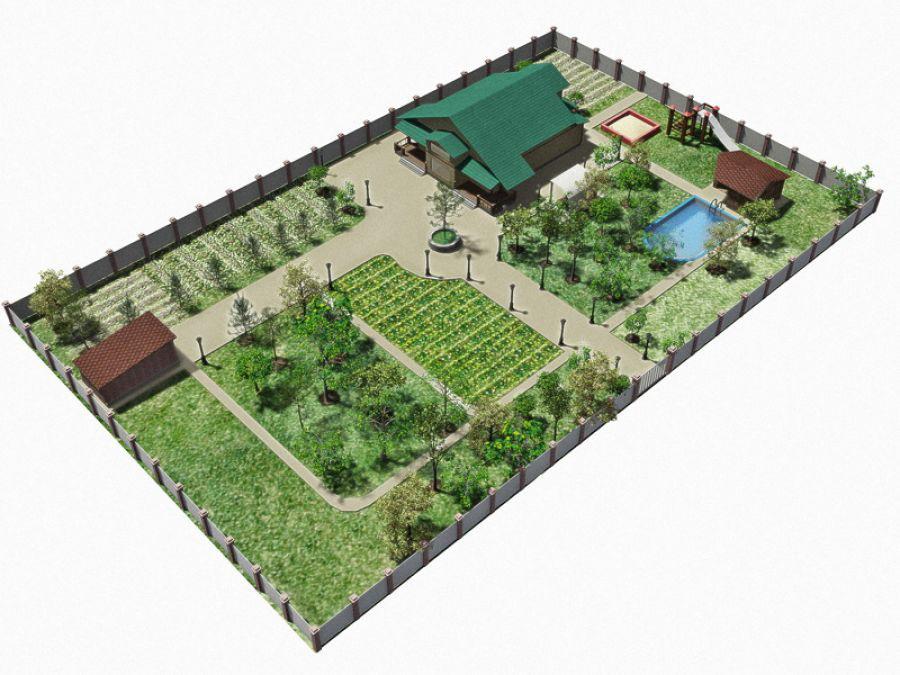
It is better to start the construction of a private house by design. You need to have a clear idea of the scope of work, otherwise the planning will be too conditional.
Documentation will take a lot of time. You need to prepare for this in advance so as not to miss the optimal time for construction.
You can not start construction work and demolition of buildings without obtaining permits for these actions. The construction of capital buildings is punishable by a fine, freezing of construction, demolition.

However, the legislation provides for the possibility of self-building, after which the owner of the site will be the owner of the property. It is better not to deal with the issue on your own, but to contact companies specializing in the legalization of such procedures. The cost of their services exceeds the cost of obtaining permits several times. And, of course, strict requirements are imposed on self-building.
After everything that is needed to build a house has been collected, you can begin to implement your plans, but before that you need to prepare the site, because the upcoming work will drag on for 2 or even 3 seasons.
Would need:

The placement of dilapidated buildings does not require obtaining permits.
A temporary fence performs several useful functions.
In rare cases, this fence remains after the construction of the house and its settlement. Therefore, the fence must meet the following requirements:
The most suitable for these parameters will be a fence made of corrugated board.
The movement of special equipment, the unloading of materials is impossible without gates. Good options would be standard swing and retractable design devices.
The simplest options for dilapidated buildings can cope with the task. A shed made of hammered boards covered with slate will provide minimal storage conditions. An advanced version of the construction consists of sheets of corrugated board. The gap between the sheets and the joints of the corners are treated with insulating materials.
We must not forget about the natural needs of the body. A temporary toilet should be placed on the site and a place for swimming should be provided.
A small seating area would be nice. You can build it or install a trailer that will serve as a place for changing clothes, and even for sleeping.
Where to start building a house with your own hands, if not from pouring the foundation. For the construction of private houses, the most suitable tape type of foundation (including small-tape), as well as slab - the most expensive, but also the most durable.
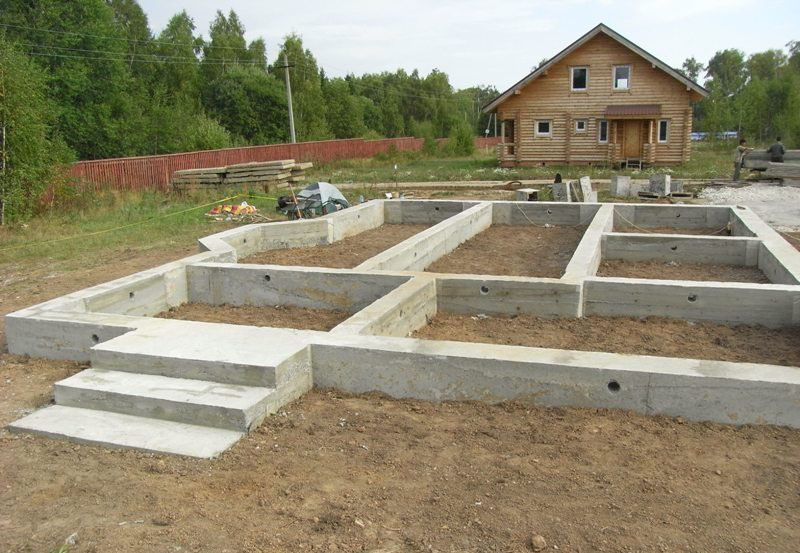
The foundation is reinforced by installing parts of the reinforcement welded together. A drainage system is created near the pouring point, through which moisture will exit. And after the foundation has stood, it is treated with waterproofing. If possible, a layer of heat insulator is also applied here to make future housing warmer.
Tips:
This part of the building is subjected to the greatest load, so it is worth taking care of the quality preparation of the base. Primary requirements:
Most durable materials are considered heavy, and light ones do not always cope with their functions. The most popular option is various brick options.
The process of erecting walls and roofs depends entirely on the type of material chosen. During this period, it is desirable to avoid the conservation of the construction site.
This is the last important point at this stage.
The house is built, but more work needs to be done on it. The final stage involves the following procedure.

Completes the construction of the blind area, which is carried out after all external finishing work. Experts recommend its installation 8-12 months after the construction of the foundation and basement. It is desirable to create an additional insulating layer of gravel or similar material under it.
You Have you already decided to build your dream home?Then choose a land not at a crossroads. Your site, for example, should not be located at the end of a valley, not near an airfield, not near a smoking factory or noisy railway. On the move Wastewater or underground mines, check if the area is flooded. Without a preliminary survey of the strength of the soil, do not place the house near the former old quarries and on the crest of the hill.
And finally, build your home, taking into account its maximum heating sunbeams in winter time. When orienting your dream home in the direction of the prevailing winds, do not forget to take into account its location., for example, in relation to the neighbor's house.
I will say right away that many owners usually do not take into account the direction of the prevailing winds, which is also an important factor in the orientation of the house on the site. From it, for example, depends on the size of the roof overhang, wetting the walls during heavy rains and picking up snowdrifts on the roof and around the house. Inattention to this leads to the fact that in winter, for example, the gate is constantly covered with snow and, at times, you have to call a neighbor for help to dig out your way out of the house.
Where to begin?
Once you build new house First of all, determine its external dimensions. I will tell you how to do this below, but remember, my presentation will not replace your textbook and regulatory materials, but will teach you to accurately and confidently start building your home. Just always remember the main goal of your plan: to create a convenient, comfortable home for your family.
As is customary, a person first chooses a place for his house and then builds his house there. Therefore, at the first stage it is necessary to collect all the data about your site. To do this, you must have a geodetic plan of your site with all its slopes, plants, heights, ravines, with its orientation to the cardinal points and an indicator of the direction of the prevailing winds. In addition, you must know the history of your site and complete description about its soils, as well as the depth of groundwater.
Further, in order to plant a house on a site, it is required to already have its "spot", that is, the contour dimensions of the future house. So it is necessary to look for a suitable architect, a house designer. Well, if you decide to build your house yourself, then you need to determine the contour dimensions of the house and plant it on the site.
Most private developers, having received the scheme of the site allocated to them, begin construction without a permit for construction work. By the way, a building permit is not required if the total area of the house does not exceed a certain size, for example, for some regions it is limited to 100 square meters.
This stage is called "obtaining a building permit". The site plan of the house with all buildings on the site is submitted for approval. Also, the set of submitted documents for obtaining a "permit" for construction is accompanied by preliminary plans and facades of all buildings and structures being designed and existing on the territory.
Therefore, I warn you that you still need to get preliminary approval for planting a house on the site with all interested authorities, for example, firefighters, gas workers and others.
This is just the main and most difficult task for a new developer. Here the ordeals and torments begin, which can last for a very long time. This is only due to the fact that the place for the future home has not been chosen on the site. It seems to you that time is rushing, it’s time to dig the foundation, but you still don’t know what size this house is and where it will stand?
Some bold "craftsmen" are already starting to pour the foundation according to the contour dimensions chosen by him, which does not exist even on paper at home. The fact is that the owner, who wants to design himself, except for the sets of premises and his ""I want it"" has no idea how to cram all this""I want"" into some particular contour.
Of course, no one argues that it is possible to create a three-dimensional layout of a residential building from a set of rooms of any shape, if there is already a certain idea about this. It requires great creative effort and knowledge, and here even a fairly experienced architect cannot do without a project.
So, the problems of such a bold decision to dig the foundation of a house without preliminary development will appear later during the design or construction of the building. Indeed, without a thoroughly coordinated project for planting a house, it is impossible to take into account all the nuances that may arise later.
For example, if you do not have a house plan project at hand, then you will have to peck a hole in the flooded foundation for a water supply or sewerage system. And if fire or other norms were violated, then the wheel will turn in the other direction.
I also want to remind you that home improvement is an endless process, and it, like life itself, never stops. Along with it, the decorative design of the house is in constant change depending on the time and fashion, even after the tenants move into an already completely finished house.
But there are other, very "cautious" people who cannot put their house on the site only because, for example, the room where their beloved daughter will sleep has not yet been selected in the plan of the house. And this reason delays the beginning of the whole course of design and construction.
The fact is that, out of ignorance, the developer wants to see the final project of the house, which needs to be put on the site plan. Mistakenly assuming that the spot of the house on the site plan is only necessary for digging the foundation, he himself delays the start of construction.
Why?
In fact, such a "spot" on the site plan is very important for preliminary design and construction work on the site. Remember that during construction, you may also need temporary outbuildings, as well as sheds for storing building materials. If you already have a landing at home, then you can coordinate it, for example, with firefighters. And also it is already possible to start designing a house, and on the site itself to do the necessary priority work.
Start bringing water and current to the spot of the house, divert sewerage, level the terrain and make fences and roads. For example, bring the water supply and sewerage networks to the main, central node of the house near its contour boundary. They are, first of all, necessary for supplying the construction site with water and current. Moreover, you carry out these very important preparatory works without worrying at all about the shape and volume of your future home.
This is a very crucial moment to correctly "tie" the chosen "spot" of the house to the plan of your site, taking into account its location on the cardinal points and roads leading to the main entrance to the house. You will have to decide on the size of your future home according to your desires, depending on your budget, as well as based on the composition of the family and the characteristics of the building site.
Still, where to start?
Let me tell you, it's very easy to do. I am not going to argue and prove here whether a house project is needed at all. And I will definitely and definitely say that even if you really hope for your good memory and on your deep knowledge of construction, a house project is necessary. The only question is how much and what kind of project should be done.
In order to avoid mistakes and misunderstandings during the design and construction of your home, you, like all large and small developers, should strictly follow the rules established by thousands of years of construction practice.
The main mistake in the search for the project of your house is jumping over certain stages of the design decisions of the future building. Moreover, since the developer wants to control all the actions of the architect himself, from the very beginning he begins to interfere in the course of the project, constantly making comments and corrections.
How then to be?
To avoid this, I advise you to immediately choose one responsible coordinator of all actions. This person can be the project architect himself or any other person you fully trust. The main thing is that this person is well versed in project documentation and construction. With this "foreman" you conclude a contract and finance it.
In this regard, I will tell you the procedure for working with contractors. Everyone knows that in the performance of any work among any group of workers there is a senior, foreman. This responsible person negotiates with the customer and is responsible for the work performed.
The same system applies to designers. A chief engineer or project architect is appointed, who receives a task from the customer and, during the entire design period, controls and distributes work between subcontractors - an architect, designer, plumber, electrician, technologist and other performers.
Why do we need a GIP and GAP?
Chief Engineer project is the most trusted person who negotiates with the customer and brings him to other performers. All documentation from start to finish design work passes through his hands, any change and disagreement are resolved only through him.
This does not mean that he is competent in all design matters. The chief engineer of the GUI project, as a journalist in television, only manages the discussion and solves all problems, including financial ones, that arise between the participants. So, for example, the distribution between adjacent groups of executors of the customer's funds depends only on him.
With this financial leverage, he achieves high-quality work of designers, that is, he can punish some for the mistakes and reward others for the quality of the project. To do this, he has his own reserve fund, with which he is insured from the customer for shortcomings in work and for failures in design deadlines.
Moreover, the chief executive officer needs to know exactly the stages of the approval of the project and tasks between subcontractors. So, for this, he must have a schedule for the transfer of tasks agreed with all project participants, for example, from an architect to a designer, to a plumber and to other subcontractors.
Such a schedule, depending on the design conditions, is different. So in the course of detailed design, the transfer of tasks from architects, for example, to plumbers and electricians, occurs only after the placement of equipment and furniture on the plans of the house. In turn, they coordinate their network layout plans among themselves and then transfer their drawings to the architect.
If there are no comments, then the architect, having agreed on the drawings, returns them to subcontractors for the final release of the project. All these processes take place directly through the GUI, which fixes the timing of the transfers and the quality of the work of the performers.
Himself GUI.
So, if you yourself play the role of a GUI, and you do some of the work yourself, for example, wiring electrical cables, then you need to get drawings of layouts and sections of the house from the architect. Then, having completed the work, you need to transfer the wiring drawings back to him. In addition, if necessary, you need to coordinate your drawings with other subcontractors.
Thus, if you do not have a trusted person in the person of the GUI, then you must take on the role of not only a customer, but also a chief project engineer. To do this, you must be familiar with design issues. Here, at a minimum, you should know the entire process of design work and the composition of project documentation.
Everyone has their own starting point to start building their home. One owner already owns a piece of land, and the second is just thinking about buying it or looking for a suitable option. Someone knows exactly what materials he will need, there are those who only collect information about construction methods. But, despite the variety of situations, what they start building a house with still has general rules and recommendations.

First of all, the developer must have two main documents in his hands: a certificate of ownership of the land and permission to build a private residential building on it. A building project is also needed, but you will acquire it at the stage of obtaining a permit for the construction itself, because without a project it simply will not be given. If these issues are resolved, you can start marking the foundation for the place that is reserved for the construction of the house. This is where the answers to the question begin: where do they start building a house? The excavation of the ground for the construction of the foundation begins. For these purposes, a team of builders is invited or an excavator is called. It all depends on how much soil needs to be removed. In the event that a concrete slab will serve as the foundation, an excavator is indispensable. If the house is supposed to be of a frame type, then a shallow strip foundation is quite suitable. It can be built on your own. Before starting concrete work, you need to take care of the presence of a concrete mixer, since working with cement is very laborious. This is where water and electricity come in handy. Well, then the construction of the foundation itself begins. The next step will be the construction of walls, roofing and finishing work. Each of the stages of construction is very important and has many details. It is important to think carefully in advance so as not to regret anything later. Good thing that detailed information on this site about each of the nuances of construction - abound.
It includes many stages and the key to ensuring that your home serves you and your grandchildren, not only the quality of construction, but also the correctness of legal registration.
If we break the construction into stages and correctly approach what it starts with, then the first is the selection and acquisition of a site on which the building will be erected. When buying, you should be based on the legal purity of the documents that establish the ownership of the seller. It is not superfluous to initially also figure out whether the premises of your new home fall under the concept of residential premises - this is determined by compliance with the requirements of the Housing Code of the Russian Federation.
Asking the question “Where to start?”, in order to properly conclude a deal, it is necessary to check the purpose of the land plot, for which the land was originally allocated - for individual residential construction (IZHS), dacha non-profit partnership, gardening and so on.
If you are buying land, you need to know:
It is necessary to study the geophysical characteristics of your site and conclude whether it is suitable for the construction of a frame or brick new house, what kind of foundation is possible on such soils.
Collecting information, studying it can take days.
How to start building a house
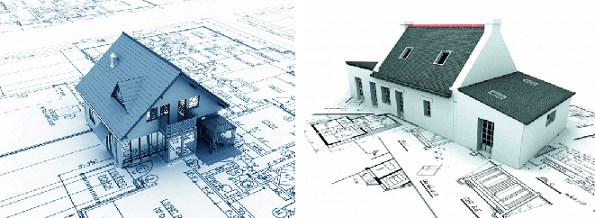
When preparing documents in order to obtain a building permit, it must be taken into account that the premises of your building are residential premises, therefore the Housing Code of the Russian Federation obliges them to comply with all fire safety requirements, environmental, sanitary and hygienic standards, and the upcoming amendments to the Housing Code of the Russian Federation will prohibit the use of residential rooms for daily rent, so you can not use them, say, as a hostel. A modern project is documents for individual housing construction that comply with the Town Planning Code, SNiP norms, legal concepts ZhK RF and construction estimate.

Properly prepared documents for a new project for a country individual house consist of 36 album sheets, which are divided into sections:
A graphic image of the building is required. It is necessary to pay attention to whether there is an estimate, which is missing in the documentation package, because in the future there may be costs that you did not expect. For example, foundation. In typical projects, it is designed for the construction of a building on a typical soil, and if your building is located on soft soils, with great content peat - the house will simply “float”.
It would not be superfluous to find those who used the services of this design organization and ask if it fulfills its obligations on time and whether its product meets the concept of "turnkey".
Projects of small private houses
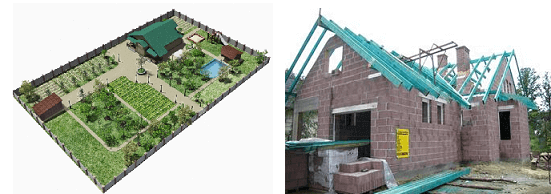
Pay attention to the fact that with an equal area, construction can cost differently, it depends on the presence of decorations of a new frame (panel) house on the facade, various architectural details, and so on. It's not about building a dull box. Just ask the IZHS designer, the organization where the estimate was made, where and for what money one or another element can be purchased.

The beautiful, artsy shape of the roof of the frame (panel) structure also hides a number of dangers. If the house has the wrong configuration. The fewer joints of roofing materials, the better.
A variation of such a foundation is the energy-saving Swedish foundation. Its cost can reach up to 7000 rubles / m³, but the high cost will provide significant savings in the future, as it will reduce heating costs.

Permission for individual construction (IZHS) - a document certifying the right of the developer to build a new frame (panel) or stone house and confirming that the project documentation is fully consistent with the plan of the site and surveying with adjacent territories.
Permission is issued on the basis of submitted documents:
Permission will not be required if your site belongs to land holdings intended for gardening or dacha farming, its premises, according to the Housing Code of the Russian Federation, cannot be classified as residential premises. Think carefully about why you need this or that room. If you plan to engage in any activity on the premises of your home, pay attention to the provisions of the Housing Code of the Russian Federation, Articles 1.7, which prohibits the use of residential premises for production activities.
The permit must be issued no later than 10 days after you submit the application and documents.

Certain rules exist not only for individual housing construction, but also for various buildings on the site. The law in the form of the Town Planning Regulations and Building Norms and Rules establishes the following:
Strict standards are also set for the distances between your non-residential buildings and the buildings of your neighbors.

The construction phase includes the supply of electricity. It is necessary for the work to be done. Produced on the basis of a personal application, which is submitted to the local electrifying organization, which will require:
The organization that will issue the permit and conduct the connection has the right to request other documents. Their study will take about a month, after which the owner receives the technical conditions for connecting the power line, on the basis of which, after agreement, a project for the electrification of the site is developed, on which installation work will be carried out.
Accurate documentation is the key to getting permission quickly. Preparation of documents, extracts, and so on will not only take time and nerves, but also certain funds, therefore it is often more profitable to entrust professionals who monitor changes in the legal field of the Russian Federation to obtain turnkey permission, since any mistake will lead to the need to start the whole process from the beginning. Do not forget - before the work, an estimate must be drawn up.
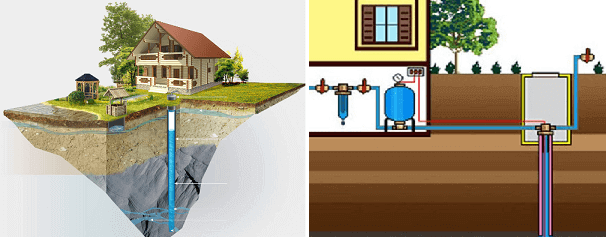
An important stage of construction is the provision of water on the site. It is best to equip your own well. Regulations require that it be located no closer than 8 m from a residential building and outbuildings. Well drilling services are offered by many companies. But these steps can be done by hand.
Where to choose a drilling site - the groundwater map available at the local executive committee will tell you. It should also be taken into account that water from a layer located at depths of 3 meters or less is unsuitable for drinking. Such small wells can be drilled using a special drill that is rotated by hand.
Work is best done during the summer season. This is due not only to the state of the soil. In the spring, during the days of snow melting, the groundwater level rises for a short time and a well drilled at this time may turn out to be inoperative on summer days.

The stages of earthworks on the site are regulated by the relevant provisions of the SNiP, which are set out in general, as well as sections 6,7,10. To carry out such work, in order to avoid trouble with regulatory authorities, it is better to order them to be carried out in a specialized company.
When deciding whether to resort to the services of professionals, remember that in order to stop the construction of a frame (panel) house and cottage and get a decision to demolish an already finished building, if it was erected with violations, it is enough for supervising state organizations to file a lawsuit in court and pay the state duty.
How to start building a house